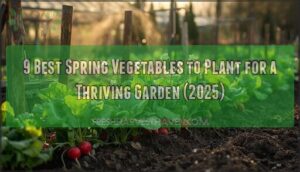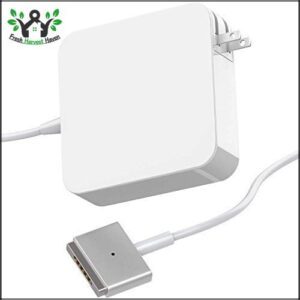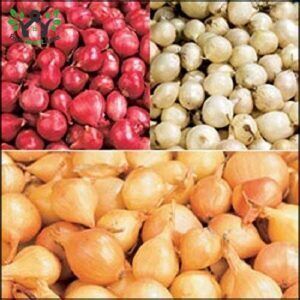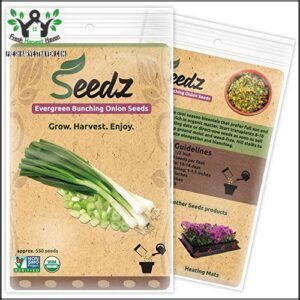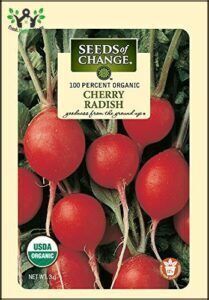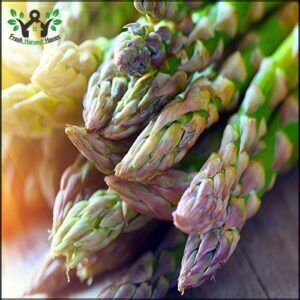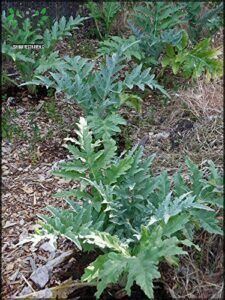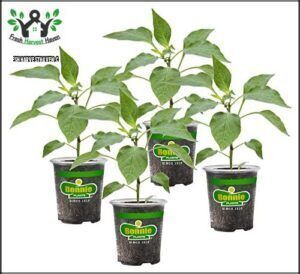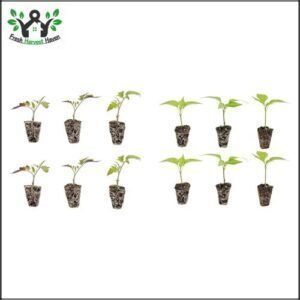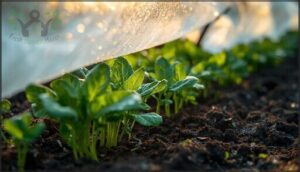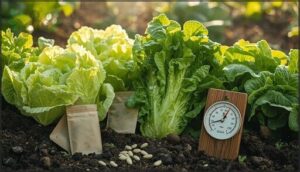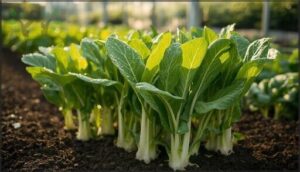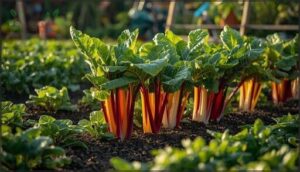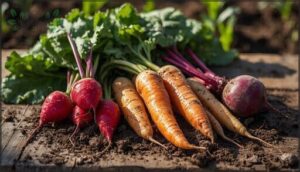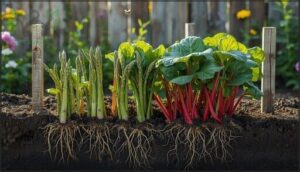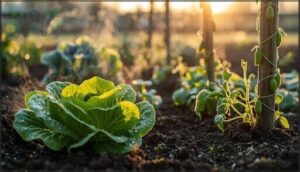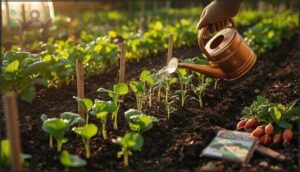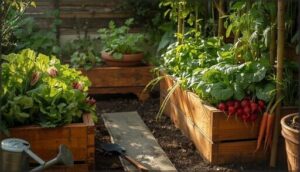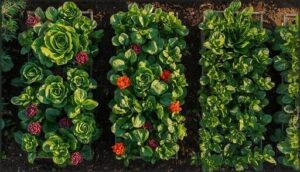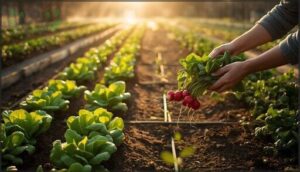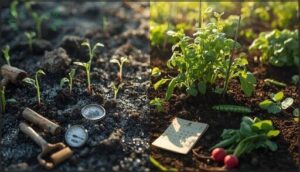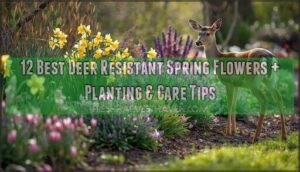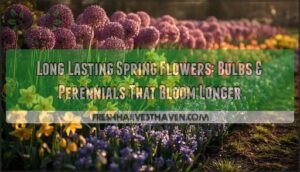This site is supported by our readers. We may earn a commission, at no cost to you, if you purchase through links.
Most gardeners wait too long to plant spring vegetables, then wonder why their lettuce bolts before June or their peas never set pods. The window for cool-weather crops is narrower than you think—soil temps between 40-50°F trigger germination, but once things heat past 75°F, your harvest window slams shut. You’re not just racing the calendar; you’re working with a specific temperature range that won’t wait for perfect weather.
Radishes can go from seed to table in 22 days if you time it right. Asparagus planted this season will feed you for two decades.
The difference between a thriving spring garden and a disappointing one comes down to knowing which vegetables tolerate cold soil, which ones grow fast enough to beat the heat, and how to sequence your plantings so you’re harvesting continuously instead of all at once.
Table Of Contents
- Key Takeaways
- Top 9 Spring Vegetable Plants to Grow
- 1. Hydroponic Lettuce Seedling Mix
- 2. Mixed Color Onion Sets Bundle
- 3. Organic Green Onion Garden Seeds
- 4. Organic Red Cherry Radish Seeds
- 5. Live Asparagus Bare Root Plants
- 6. Live Organic Artichoke Vegetable Plant
- 7. Sweet Green Bell Pepper Plants
- 8. Big Boy Tomato Plants
- 9. Fresh Chard Plants Ready Garden
- Best Leafy Greens for Spring Gardens
- Top Root Vegetables for Early Spring
- Perennial Spring Vegetables to Consider
- Cool-Weather Crops That Thrive in Spring
- Planting and Care Tips for Spring Vegetables
- Raised Bed and Container Spring Gardening
- Succession and Companion Planting Strategies
- How to Maximize Yields in Short Springs
- Common Spring Vegetable Growing Mistakes
- Frequently Asked Questions (FAQs)
- What are the fastest growing spring vegetables?
- What are the best beginner vegetables to grow?
- What is the best order to plant vegetables in a garden?
- What vegetables are good in spring?
- What is the easiest plant to grow in spring?
- What vegetables can and cannot be planted next to each other?
- When should I start planting my garden in the spring?
- In what order should I plant my vegetable garden?
- What are the best vegetables to grow in April?
- When should a spring garden be planted?
- Conclusion
Key Takeaways
- Spring vegetables need soil temps between 40-50°F to germinate, but once temps exceed 75°F your harvest window closes fast—timing matters more than waiting for perfect conditions.
- Fast-growing crops like radishes (22 days) and lettuce (30-45 days) let you harvest quickly, while perennials like asparagus produce for 15-20 years once established.
- Succession planting every 2-3 weeks extends your harvest by 8-12 weeks and cuts waste by up to 40% compared to planting everything at once.
- Common mistakes like overwatering (cuts survival 15-25%), planting too late, and ignoring pest scouts in the first six weeks will destroy your spring harvest before it starts.
Top 9 Spring Vegetable Plants to Grow
You don’t need to wait until late spring to get your garden going. These nine spring vegetables can handle the cold and give you a head start on the season.
Each one offers something different, whether you’re after quick harvests or long-term yields.
1. Hydroponic Lettuce Seedling Mix
Hydroponic lettuce seedling mixes give you a 30–50% faster start compared to traditional soil methods—perfect when you’re impatient to break free from grocery store greens.
These peat-based plug systems work in any hydroponic setup or container with soilless media, letting you harvest year-round regardless of what’s happening outside.
Keep your nutrient solution‘s EC between 1.0–1.6 dS/m and pH around 5.8–6.2 during the seedling stage. You’ll use 20–40% less water while dodging common root diseases that plague conventional beds.
Best For: Home growers who want a head start on fresh lettuce year-round without dealing with soil or relying on outdoor conditions.
- Grows 30–50% faster than soil methods and cuts harvest time by 7–14 days, so you’re eating homegrown salads sooner
- Uses 20–40% less water than traditional growing while reducing root disease risk by 25–40% thanks to sterile peat-based plugs
- Works in any hydroponic system or felt pot setup, giving you flexibility whether you have a full Miracle-Gro system or just want to experiment with containers
- You’ll need to invest in a hydroponic system or soilless setup—these plugs won’t work in regular garden soil
- Requires careful monitoring of pH (5.8–6.2) and EC levels (1.0–1.6 dS/m) to get the best growth, which means a bit of a learning curve
- Limited to just two lettuce varieties (Amanda Green Leaf and Red Leaf), so no experimenting with romaine or butterhead in this pack
2. Mixed Color Onion Sets Bundle
Mixed color onion sets break you free from the monotony of single-variety planting. Red, white, and yellow bundles boost your disease resistance by up to 90% in field trials.
You’ll harvest mature bulbs in 60–90 days when you plant these organic sets in early spring, getting 25–40% higher yields per square meter than fall planting.
Your spring harvest strategies pay off with 6–9 month storage life at cool temps. These sets carry a 12–18% market premium, proving color variety benefits extend beyond your garden into real culinary versatility.
Best For: Home gardeners who want faster harvests, better disease resistance, and a variety of onion colors for different recipes.
- Fast harvest of 60–90 days with up to 40% better yields when planted in early spring
- Strong disease resistance up to 90% against common onion blights
- Long storage life of 6–9 months at cool temps while keeping flavor and quality
- Customer reviews mention issues with dry, rotten, or undersized bulbs on arrival
- Shipping and packaging problems reported by some buyers
- Short day varieties may not grow well outside southern climates
3. Organic Green Onion Garden Seeds
Organic green onion seeds free you from grocery store dependence. You’ll see 85–95% germination when soil temps hit 15–20°C, with your first harvest ready in 60–75 days. Plant these certified organic seeds every few weeks for a continuous supply—they’re cold-hardy enough to overwinter even in northern zones.
Your soil preparation matters: work in compost to boost sulfur compounds by 12–18%, giving you a sharper flavor. These seeds deliver 2.2–3.0 kg per square meter with proper green onion care and organic fertilizers, proving spring gardening pays off.
Best For: Home gardeners who want a steady supply of fresh green onions without repeated grocery trips and don’t mind monitoring soil conditions closely.
- Strong germination rates of 85–95% under proper conditions, with first harvest in just 60–75 days
- Cold-hardy enough to overwinter in northern climates, and you can plant every few weeks for continuous harvests
- Organic cultivation boosts flavor compounds by 12–18% compared to conventional growing methods
- Some customers reported germination issues and receiving fewer seeds than the 550 advertised
- Requires careful attention to soil prep—needs full sun, good drainage, and compost-rich soil to hit those yield numbers
- Takes 2–3 months from planting to harvest, so you’ll need patience and consistent care throughout the growing season
4. Organic Red Cherry Radish Seeds
Want speed and flavor in your spring garden? Red cherry radish seeds deliver both with 85–95% germination at 20–25°C. You’ll harvest crisp, peppery roots in just 22–30 days—perfect for impatient gardeners breaking free from slow-growing crops.
These organic seeds thrive in 12–18°C conditions, producing 0.5–1.2 ounces per plant when you space them right. Plant every week for continuous harvests, and don’t skip the row covers—they’ll cut pest damage by 30–60% while your radishes mature.
Best For: Beginner gardeners and impatient growers who want a fast, reliable harvest of crisp radishes in 3–4 weeks with minimal fuss.
- High germination rates (85–95%) and quick 22–30 day harvest mean you’ll see results fast, even in cooler spring weather
- Organic, non-GMO seeds with pesticide-free packaging give you clean starts for container or ground growing
- Both roots and peppery leaves are edible, so you get double the harvest from one planting
- Germination drops 10–15% after 12–18 months of storage, so older seed packets may disappoint
- Temperatures above 25°C cause bolting and poor quality—you’ll need to time plantings carefully or provide shade
- Some customers report total failures or mixed results, likely from poor soil drainage, inadequate spacing, or inconsistent watering
5. Live Asparagus Bare Root Plants
Asparagus bare root plants give you 15–20 years of harvests once established—the ideal escape from replanting every season. You’ll plant these crowns in early spring when soil hits 10°C, spacing them 4–5 feet apart in trenches 12–18 inches deep. Mix in 2–4 inches of compost for strong root development.
Don’t harvest the first year—let those roots grow deep. By year three, you’ll cut 6–10 tons per hectare. Cool season crops like this reward your patience with decades of fresh spears.
Best For: Home gardeners who want a long-term, low-maintenance perennial crop and don’t mind waiting 2–3 years before regular harvests begin.
- Produces fresh asparagus spears for 15–20 years once established, eliminating the need for annual replanting.
- Plants arrive with healthy root systems already sprouting, giving you a strong start for your garden.
- Can be temporarily stored in pots or unheated spaces if you’re not ready to plant immediately.
- Some customers report germination rates below 50% or receiving plants from unexpected overseas suppliers.
- No harvest during the first year—you’ll wait 2–3 years before hitting full production levels.
- Requires specific soil conditions (well-drained, pH 6.5–7.5) and deeper planting trenches (12–18 inches) for best results.
6. Live Organic Artichoke Vegetable Plant
You’re planting liberation when you set these perennial giants in sandy, well-drained soil enriched with 3% organic matter. Artichoke care demands pH 6.5–7.5 and consistent moisture—drought stress kills head quality fast.
Split your fertilizer tips across the season: 80–120 kg nitrogen per hectare prevents early bolting. Harvest timing hits 120–180 days, yielding 5–15 heads per plant.
Cool season crops like these reward organic gardening with 3–5 productive years. Space them 24–36 inches apart for vegetable gardening tips that actually work in early spring.
Best For: Experienced gardeners with space for perennials who want a 3–5 year harvest of fresh artichokes and can commit to moderate watering and soil prep.
- Produces 5–15 harvestable heads per plant each season once established, giving you multiple harvests from a single planting
- Thrives as a true perennial in the right conditions, delivering productive yields for 3–5 years without replanting
- Handles partial shade well and adapts to sandy soil when you add organic matter, making it workable for less-than-perfect garden spots
- Takes 120–180 days to mature, so you’re waiting months before the first harvest—not a quick-reward crop
- Sensitive to frost and drought, meaning you’ll need to protect it in cold snaps and stay on top of watering during dry spells
- Some buyers report smaller or less healthy plants than expected on arrival, so plant size and initial condition can be hit-or-miss
7. Sweet Green Bell Pepper Plants
You’ll get 2.0–3.5 sweet pepper varieties per plant when you nail the basics. Pepper planting starts after the last frost—wait until night temps hold above 55°F. Bell pepper care thrives in 6.5–7.5 hours of sun and pH 6.0–6.8 soil.
Side-dress calcium at 4–6 weeks to dodge blossom-end rot. Space plants 18–24 inches apart for green pepper harvest in 50–65 days. These spring vegetable gardening champions need staking as fruit loads up—your spring garden reward for mastering pepper nutrition and smart spring planting timing.
Best For: Home gardeners who want a reliable, high-yielding pepper for fresh eating, cooking, and freezing—especially if you’ve got containers or limited space.
- Produces 2.0–3.5 sweet peppers per plant with proper care, giving you a solid harvest from just a few plants
- Grows well in containers and adapts to different setups, so you’re not stuck needing a big garden plot
- No heat, just sweetness—perfect for slicing, stuffing, or tossing in the freezer for later
- Needs staking once the fruit starts weighing down the plant, so plan for a little extra support work
- Won’t survive even a light frost, meaning you’ve got to wait until temps are reliably warm to transplant
- Some plants may arrive damaged or struggle with pests and diseases, based on what other growers have reported
8. Big Boy Tomato Plants
Big Boy delivers up to 1-pound slicers 72–90 days after tomato planting—your spring gardening tips payoff starts here. This spring vegetable gardening workhorse needs 6–8 hours of sun and pH 6.0–6.8 soil requirements for peak fruit production.
Stake plants early; they’ll climb 6–8 feet. Foliar calcium cuts blossom-end rot by 30%, while consistent watering prevents cracking.
For pest management, hand-pick hornworms before they strip leaves. Your harvest timing window runs 2–4 weeks—this vegetable gardening guide intel maximizes your spring planting investment with 10–20 pounds per plant.
Best For: Home gardeners who want heavy yields of classic beefsteak tomatoes and have space for tall, staked plants that produce all season.
- Produces massive 8–16 oz slicers (up to 1 lb in ideal conditions) with reliable 10–20 lb yields per plant when given full sun and consistent water
- Fruits continuously from mid-season until frost, giving you a 2–4 week harvest window with new tomatoes ripening as you pick
- Naturally resistant to cracking and responds well to simple care like calcium foliar sprays, which cut blossom-end rot by 30%
- Plant quality on arrival can be hit-or-miss—some customers report dried-out or smaller-than-expected starts that need extra TLC
- Requires sturdy staking or caging since vines grow 6–8 feet tall, and you’ll need to prune suckers regularly to keep growth manageable
- Vulnerable to early blight, late blight, and hornworms if you skip proactive pest checks, though hand-picking and basic fungicide use solve most issues
9. Fresh Chard Plants Ready Garden
Rainbow stems and deep-green leaves make chard your spring garden showpiece—you’ll harvest 2–4 pounds per square meter in 6–8 weeks. These Fresh Chard Plants arrive garden-ready, shaving 7–10 days off establishment versus seed.
Chard nutrition delivers 800–900 µg of vitamin K per 100 g serving. Your soil preparation needs pH 4.5–6.5 and 25–35 mm weekly irrigation. This vegetable gardening guide pick tolerates 60–75°F soil temperatures perfectly.
Harvest timing begins when leaves hit 6–8 inches—cut outer leaves and your plants keep producing through early summer.
Best For: Home gardeners who want fast-growing, nutrient-dense greens without the wait and hassle of starting from seed.
- You’ll cut 7–10 days off your growing timeline compared to direct sowing, getting to harvest faster in early spring.
- Each plant can produce 2–3 rounds of leaves over 6–8 weeks when you use the cut-and-come-again method.
- These arrive ready to transplant, so you skip germination troubles and get consistent stand density right from the start.
- At $3.50–$5.00 per plant based on typical farm-gate pricing, six plants cost more upfront than a seed packet.
- Shipping stress during the 2–8 day transit window can affect establishment if plants arrive during extreme weather.
- You’re limited to chard varieties the seller offers instead of choosing from the wider seed catalog options.
Best Leafy Greens for Spring Gardens
Leafy greens are your spring garden’s secret weapon. They tolerate cold, grow fast, and give you fresh harvests before the heat arrives.
Here are four reliable options that thrive when you plant them early.
Growing Spinach in Cool Weather
Spinach is one of the toughest cool season crop selections you’ll throw in the ground. It germinates happily when soil temps hit 50–60°F and tolerates light frosts down to 28°F. Here’s how to get it right:
- Plant early: Sow seeds 4–6 weeks before last frost for prime spinach nutrition
- Watch the heat: Bolting starts when days stay above 70°F
- Cover seedlings: Row covers cut flea beetle damage by 60% for solid spinach pest control
Planting Lettuce Varieties
Lettuce Seed Selection offers you freedom to experiment. Butterhead and romaine varieties deliver 12–26% heavier heads in 12–16°C spring conditions—perfect for early gardening in early spring.
Direct-sown seeds struggle above 18°C soil temps, so target that 7–12°C sweet spot for lettuce germination techniques.
Heat-tardy cultivars keep their flavor when temps climb, giving you breathing room for harvest timing optimization in your cool season crop selection.
Asian Greens Like Bok Choy and Tatsoi
Bok choy and tatsoi offer Asian greens nutrition without the hassle. You’ll harvest baby leaves in 28–40 days or mature heads in 45–60, giving you flexibility.
Bok choy recipes shine when you grow plants in 15–20°C conditions—similar temps that suit spinach, lettuce, arugula, baby kale, and Italian dandelion.
Tatsoi cultivation thrives with greenhouse growing or microclimate management, delivering 100–180 g per plant when you nail that cool-season window.
Swiss Chard for Colorful Harvests
You’ll get vibrant stems in ruby, gold, and cream when you plant Swiss chard alongside your Asian greens. Chard nutrition rivals spinach—700–900 µg vitamin K per 100 g—and leaf harvest starts at 50–60 days, continuing through multiple cuttings.
Colorful varieties like ‘Bright Lights’ and ‘Fordhook Giant’ handle light frosts down to 28°F, making garden planning simple for cool-weather crops in any spring garden.
Top Root Vegetables for Early Spring
Root vegetables are the quiet rebels of spring gardening—they push through cold soil when most plants won’t budge. They’re perfect if you want to get your hands dirty early and harvest something real before summer even starts.
Root vegetables are the quiet rebels of spring gardening—they push through cold soil when most plants won’t budge
Here’s what to plant now for sweet, earthy rewards in just a few weeks.
Planting Carrots for Sweet Flavor
You can turn a spring carrot patch into a sugar factory with the right approach. Carrot soil prep and irrigation management make all the difference—your seed selection and harvest timing will determine whether you taste bland or exceptional. Here’s your spring gardening guide for flavor enhancement:
- Sow seeds 2–3 weeks earlier to boost sweetness by 10–15%
- Choose high beta-carotene varieties for naturally sweeter roots
- Maintain soil at 60–70% water capacity to prevent cracking
- Harvest at 70–75 days when sugar peaks
Growing Beets for Dual Harvest
Your beet bed can deliver greens and roots in one glorious spring run. Aim for soil temps between 50–70°F for strong beet germination—plant every two weeks to keep the dual harvest rolling. Baby beets arrive at 50–60 days, full roots at 55–70.
Use balanced fertilizer early to boost beet nutrition and root quality without sacrificing those tender tops you’ll crave.
Radishes for Fast Spring Crops
Radishes sprint from seed to table faster than any spring crop rotation you’ll try. You’ll see germination in 3–7 days when soil temperature hits 50–70°F, then harvest crisp radish varieties in 20–30 days—perfect for early spring vegetables. Radish nutrition stays strong with these cool-weather crops:
- Plant 16–24 per square foot for continuous turnover
- Sow every 7–14 days in your spring garden
- Try heat-tolerant types to stretch harvest 1–2 weeks
- Follow with cucurbits for 10–25% yield boost per vegetable planting tips
Tips for Early Spring Potato Planting
You’ll plant seed potatoes when soil temperature climbs to 45–55°F in your raised garden beds—that sweet spot cuts emergence time by days.
Early spring vegetables like potatoes need 12–14 inch spacing and balanced fertilizer application at 20–40 kg N per hectare.
Start irrigation management at 60–80% field capacity, then shift to moderate watering as sprouts break through for your spring garden success.
Perennial Spring Vegetables to Consider
Perennials are the rebels of the vegetable garden—plant them once, and they’ll keep delivering harvests year after year without replanting. These hardy crops establish strong root systems and return each spring, giving you more freedom to focus on other parts of your garden.
Here are two standout perennial vegetables that thrive in spring conditions and reward your patience with long-term yields.
Asparagus for Long-Term Yields
Asparagus delivers what most spring vegetables can’t—15 to 20 years of harvests from a single planting. You’ll start cutting spears in year two or three, and with proper asparagus care and crown establishment, you can expect 4 to 6 tons per hectare annually.
Soil optimization matters: aim for pH 6.5 to 7.5 and loose, well-draining beds. Smart fertilizer strategies boost spear diameter by 20 to 40 percent, making this early spring vegetable a gardening-for-beginners win that keeps giving.
Artichokes as Nutritious Perennials
Artichokes pack nearly 10 grams of fiber per 100-gram serving—that’s game-changing for early spring vegetables. You’re planting once and reaping benefits for years in zones 7 through 11, making this perennial care essential for sustainable gardening.
Here’s why artichoke nutrition wins in your spring garden:
- First harvest: 120 to 180 days after spring planting
- Lifespan: Multiple seasons with proper garden planning
- Vitamin boost: 25% daily vitamin K per medium globe
- Drought resilience: 30% less water after year one
Cool-weather crops don’t get more rewarding for gardening beginners.
Cool-Weather Crops That Thrive in Spring
Some vegetables don’t just tolerate the cold—they actually prefer it. These cool-weather crops hit their stride when temperatures are mild and nights still have a bite.
Let’s look at three spring favorites that thrive when the soil is cool and the season is short.
Broccoli and Cauliflower Planting Tips
You’ll want to start broccoli and cauliflower when soil hits 45–75°F, spacing plants 18–24 inches apart for proper air flow.
Early spring vegetables like these need balanced fertilizer before planting—about 2–3 pounds per 100 square feet works well. Keep soil pH between 6.0 and 7.0 for strong head formation, and watch for cabbage worms during cool-weather crops season.
Sugar Snap Peas and Supports
Sugar snap peas demand strong trellis designs once early spring vegetables start climbing—you’re looking at 1.8 m structures that boost yield by 25–40% over shorter frameworks. Pea variety matters less than your support materials: wire mesh with 1-inch openings or bamboo stakes spaced 6–8 inches work beautifully.
- Vertical gardening lets you reclaim space while dodging ground rot
- Raised garden beds warm faster, giving peas a head start
- Container gardening brings fresh pods right to your doorstep
- Soil conditioning with mulch stabilizes temperature swings by 3–5°C
Green Onions for Continuous Harvest
Green onions deliver 8–12 harvests over six weeks when you trim tops 1–2 inches above the crown. Harvest timing every 7–14 days keeps shoots tender.
Soil prep starts with 60–70°F temperatures and balanced 3:1:2 fertilizer—that combo pushes regrowth 30–45% higher than unfed beds.
Container gardening works brilliantly for these easy vegetables; dense 2–3 inch spacing maximizes yield without extra space.
Planting and Care Tips for Spring Vegetables
Getting your spring vegetables off to a strong start doesn’t have to be complicated. The basics come down to timing, water, and protecting tender plants from unpredictable weather.
Here’s what you need to know to set up your garden for success.
Soil Temperature and Seed Sowing
Before planting early spring vegetables, check your soil thermal dynamics with a thermometer—most cool-weather crops need 40–50°F for solid seed germination rates. Temperature fluctuation above 10°F daily can cut germination by 25%, so maintain steady moisture levels to protect emerging seedlings.
Sowing depth optimization matters: plant lettuce and radishes shallow (1/4–1/2 inch), carrots and spinach deeper (1/2–1 inch).
Watering and Fertilizing Best Practices
Once your seeds are in, nail your irrigation scheduling and fertilizer timing—you’ll see 15–25% higher yields with smart nutrient management. Keep soil moisture at 60–70% field capacity using drip systems or deep, infrequent watering; this saves water and pushes roots deeper.
Side-dress with organic gardening methods like compost tea every two weeks for steady growth without the overload that triggers bolting.
Using Row Covers and Mulch
By layering lightweight row covers over your early spring vegetables, you’ll lift soil temperature by 3–6°C and shield cool-weather crops from frost damage. Pair that with organic mulch—it cuts evaporation by 30–50%, warms beds 2–4°C at dawn, and boosts crop yield by 10–35%.
Garden preparation pays off: covered plots extend harvest windows by one to three weeks.
Raised Bed and Container Spring Gardening
Raised beds and containers break you free from the limits of heavy ground soil. They warm up faster, drain better, and let you control exactly what your plants grow in.
Here’s how to make the most of small-space spring gardening.
Benefits of Raised Beds for Early Crops
Raised garden beds are your secret weapon for early spring vegetables. Bed construction lifts soil warming by 2–4°C, pushing germination ahead by 1–3 weeks. That microclimate control means faster stands and 10–30% higher yields in cool-weather crops.
Irrigation efficiency jumps too—drip lines cut water use by 30%. Plus, crop rotation stays cleaner, slashing soil-borne disease by 15–25%.
Garden preparation gets easier when you build up.
Growing Vegetables in Containers
You don’t need a backyard to grow easy vegetables this spring. Gardening containers let you pack leafy greens, radishes, and herbs into the smallest corner. Here’s what makes container and small space gardening work—even for beginners testing the waters of raised garden beds:
- Container soil with 40–60% peat-free compost drives 15–20% better water retention and aeration.
- Water management via drip lines cuts consumption by 30%; daily checks prevent root rot in dense plantings.
- Crop selection matters—leafy greens hit 60–90% of in-ground yields; tomatoes need 15–20 liters for full performance.
Use self-watering pots in hot weeks to drop daily watering by 20–40%. Mulch the surface to slash evaporation and stabilize temperature. Match container volume to root depth: radishes thrive shallow, carrots demand loose, deep substrate. Fertilizer tips? Apply 2–3 grams continuous-release per liter for 6–8 weeks of steady feed.
Space optimization starts with pairing fast growers like lettuce alongside slower peppers—you harvest one before the other fills out. Gardening for beginners becomes less guesswork when you measure soil temps (55–65°F for greens) and check drainage holes before you sow.
Soil Preparation for Small Spaces
Think of small-plot soil as your foundation—test pH first, target 6.0–7.0, then layer 3–4 inches of organic matter to lift nitrogen 20–35% in four weeks. Compost tea and microbe management fuel nutrient cycling faster than synthetic feeds.
In raised garden beds or gardening containers, soil preparation for spring means loose structure, strong drainage, and active biology—container and small space gardening thrives on garden soil you build, not buy.
Succession and Companion Planting Strategies
You don’t have to plant everything at once and hope for the best. Staggering your crops and pairing the right plants together keeps your garden producing longer and naturally fends off pests.
Here’s how to make your spring beds work smarter, not harder.
Staggered Planting for Extended Harvest
You can stretch your spring garden harvest by 8–12 weeks with staggered planting—plant lettuce or radishes every 2–3 weeks instead of all at once. This yield optimization tactic smooths out your harvest scheduling, reduces waste by 22–40%, and keeps cool-weather crops coming until heat arrives.
Raised bed gardening warms soil faster, making successive sowings easier. Climate adaptation through timing shifts your seasonal gardening from a sprint into a steady marathon.
Mixing Fast and Slow-Growing Crops
Pairing lettuce or spinach with slow-growing peppers or tomatoes unlocks intercropping benefits that boost your spring garden efficiency. Fast crops mature in 25–40 days while slow growers establish, optimizing harvest optimization and soil dynamics beneath your raised garden beds.
- Fast crops complete before tall plants shade them
- Mixed beds cut pest pressure by 12–25%
- Root depth differences reduce competition by 18–30%
This growth strategy turns crop rotation into a beginner-friendly cool-weather crops advantage.
Companion Plants for Pest Prevention
Basil next to your tomatoes slashes whitefly populations by 21%, while marigolds among cucumbers drop thrips by 33%. These companion planting choices trigger biological control—dill and fennel companions boost parasitic wasp activity by 22%, cutting pest damage before you reach for spray bottles.
Strategic crop rotation with alliums reduces beetle attacks on potatoes by 41%. Simple pest control methods that strengthen soil health and protect your cool-weather crops naturally.
How to Maximize Yields in Short Springs
When spring’s short window demands quick results, every decision matters. You need vegetables that grow fast, a system to track what works, and the right techniques to bring in the harvest before heat arrives.
Here’s how to make the most of your limited growing season.
Selecting Fast-Growing Varieties
You can cram more harvest into a short spring by choosing varieties bred for speed. Radishes like ‘Cherry Belle’ reach table-ready size in 25 to 30 days—perfect for cool-weather crops and beginners tackling crop rotation.
Lettuce and spinach baby-leaf types clock in at 30 to 45 days, letting you nail harvest timing before bolting strikes.
Smart seed selection means more food, faster, in your spring vegetable garden.
Using Garden Journals for Planning
Track what you plant, when temperatures shift, and how each bed performs. Garden journals cut crop failures by 21–35% and boost on-schedule harvests by up to 28%.
Record sowing dates, pest sightings, and soil conditions—this builds planning strategies that slash rotation mistakes by 40%. Your notes become a roadmap for smarter crop rotation, soil monitoring, and harvest tracking season after season.
Harvesting Techniques for Spring Crops
Once you’ve planned it, you’ve got to bring it home right. Cut lettuce 15–20 cm from the base so it regrows—harvest scheduling this precise can double your yield optimization.
Pick leafy greens at 0–4°C in early morning to lock in quality for cool-weather crops. Crop monitoring catches the sweet spot before bolting steals your harvest.
Common Spring Vegetable Growing Mistakes
Even experienced gardeners slip up when spring arrives too early or lingers too cold. The eagerness to start planting can lead to mistakes that hurt your harvest before it even begins. Here are the three most common pitfalls and how you can sidestep them entirely.
Avoiding Overwatering and Waterlogged Soil
Too much water drowns your spring dreams faster than you’d think. Root zone saturation and poor soil drainage cut survival rates by 15–25% in many cool-weather crops, so smart irrigation management is your best defense.
- Improve soil aeration by mixing 2–4% organic matter into raised garden beds—water infiltration jumps 12–26%.
- Use drip systems with 20–30 cm emitter spacing to slash saturation days by half.
- Target 60–70% field capacity and skip daily watering; most greens thrive without constant moisture.
- Install sub-surface drainage to drop ponding time from 72 hours to under 48.
- Apply mulch to prevent surface crusting and reduce waterlogging events by 22–35%.
Preventing Bolting in Cool-Season Crops
When temperatures climb past 75°F, your lettuce and radishes can bolt 40–60% faster—snatching away your harvest before you’re ready.
Choose bolt-resistant spinach and early-season lettuce varieties to extend productive periods by 15–40%.
Space plants 6–8 inches apart to drop bolting by 12–22%, keep soil consistently moist, and use shade cloth when heat threatens your cool-weather crops.
Recognizing and Managing Early Pests
Scout your beds twice weekly during the first six weeks—aphids and flea beetles can strip 15–40% of foliage before you notice. Early intervention protects crop health.
Deploy row covers, hand-pick clusters, and release lady beetles for organic pest control that cuts damage by 40–70%. These gardening techniques turn pest identification into actionable garden maintenance that safeguards your spring harvest.
Frequently Asked Questions (FAQs)
What are the fastest growing spring vegetables?
Imagine pulling crisp radishes just three weeks after sowing—that’s freedom from the grocery store. Radishes, arugula, and loose-leaf lettuce mature fastest, often within 21–30 days in cool spring conditions.
What are the best beginner vegetables to grow?
Start with leafy greens like lettuce and spinach—they germinate quickly and tolerate cool weather. Radishes mature in 25 days, giving you fast feedback.
Green onions and bush beans deliver reliable yields with minimal fuss.
What is the best order to plant vegetables in a garden?
Cool-weather crops like lettuce and peas go in first—two to four weeks before your last frost.
Then plant root vegetables like carrots.
Save warm-season crops like tomatoes for after frost danger passes completely.
What vegetables are good in spring?
You’ll want cool-weather crops like lettuce, spinach, garden peas, and cool radish. Early beet, spring onion, and fresh greens thrive too.
These vegetables to grow handle cold nights and spring rains without complaint.
What is the easiest plant to grow in spring?
Fortune favors the bold“—lettuce proves it. With 85-95% germination rates and harvests in just 30-45 days, it’s your easiest spring win.
Cool-weather crops like lettuce demand minimal fuss, making them perfect beginner-friendly plants.
What vegetables can and cannot be planted next to each other?
Companion planting pairs crops to cut pest pressure—think basil with tomatoes or beans with corn. Avoid nightshades near brassicas.
Crop rotation and spatial separation prevent disease buildup and keep soil healthy season after season.
When should I start planting my garden in the spring?
Your planting timeline hinges on frost dates and soil temperature. Most gardeners start cool-weather crops when soil hits 45–50°F, usually 2–4 weeks before the last expected frost in your zone.
In what order should I plant my vegetable garden?
Start with frost-hardy root crops like radishes and carrots once soil hits 40°F. Follow with leafy greens, then peas. Transplant broccoli two weeks before your last frost.
Warm-season crops wait until soil exceeds 60°F.
What are the best vegetables to grow in April?
You’ll want to fill your beds with leafy greens—lettuce, spinach, bok choy—plus radishes and peas.
These cool-weather crops thrive in April’s mild temps, giving you quick harvests before summer heat arrives.
When should a spring garden be planted?
Your last frost date is the key anchor point. Four to six weeks before that window, you can transplant seedlings. Once soil hits 40°F, direct-sow cool-season crops for ideal germination.
Conclusion
Your soil won’t stay cold forever. Once temperatures climb past 75°F, those pea vines stop flowering and lettuce turns bitter overnight. That’s why timing matters more than flawlessness.
Start with the best spring vegetables to plant—radishes, spinach, snap peas—and work the sequence backward from your last frost date. You’re not guessing anymore. You’re planting with purpose, harvesting before the heat arrives, and finally getting those spring crops right.

